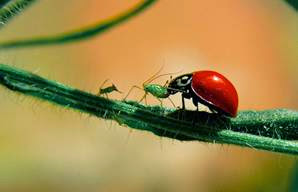Rainy season in South Florida can mean ants moving indoors. Here’s some ‘natural’ solutions to that problem.
Mar 27, 2012
Ants are making their way into homes this time of year. Thankfully there are natural pest control methods to help you cope with and eliminate the problem. Plus, many of the solutions use what you already have in your cupboard!
Little tiny ants have been spotted in our new home, and many people are suffering the same fate across the country. As much as I love spring, I don't like bugs — especially bugs that can infest a house. Last week I asked for some advice in how to deal with ants naturally as I didn't have time to research it myself since I just moved this weekend. I got such good advice, I had to share it with the readers here at MNN as well.
Some of these measures are deterrents. That is, they deter the ants from coming in your house. This seems to work well for those with a mild problem. Others found that they needed to use a method that kills the whole colony of ants. I've compiled the comments and suggestions by category, allowing you to compare the different methods a little more easily.
1. Lemon juice
Teresa: We just spray around the openings with pure lemon juice … and it always works for us … something about the acid messes up their sense of tracking…
2. Cinnamon
Shayla: We use ground cinnamon around where there are coming it. It works really well.
Peggy: We spray cinnamon essential oil all around the doors, windowsills, floors, etc. keeps them from coming in. I put the sugar water and borax OUTSIDE!
Letia: Another vote for ground cinnamon. Easy to clean up afterwards and worked great for us!!!
Jean: Cinnamon and cloves. Makes your house smell nice and the ants just hate it sprinkled right in their path.
Patricia: We also use cinnamon oil. We draw borders around everything with a Q-tip dipped in it. They won’t cross it.
3. Peppermint
Heather: My mother-in-law has success with peppermint essential oil around windows and doors (any entries). Plus her house then smells awesome.
Julie: Dr. Bonner’s liquid soap in the mint aroma. Mix 1 to 1 with water in a spray bottle. Spray on the ant invasion and watch them suffer.
4. Borax, water and sugar
Kristi: We use borax, sugar, water and a touch of peanut butter. It takes a couple of weeks but really works. We used it last year in our old house and are implementing it again this spring in our new house. Pesky ants! Here is the site where I found the recipe: http://naturalantkiller.blogspot.com/
Christy: I second Diana’s comment about borax and sugar. I’ve made a thin paste before with water, sugar and borax, then spread it on little pieces of thin cardboard or stiff cardstock and placed them near where it seems they are coming into the house. They’ll eat it and take it back to their colony (just like the Terro liquid you can buy). The paste will dry up in a couple days, so you’ll have to make more. But I think I only had to do it twice before they were gone.
Chookie: What worked for us was a mixture of borax and sugar in water. Several years ago, we lived in a house where there was an ants nest in the walls. Removing it would have meant virtually demolishing the entire front wall of the house (not practical!), so instead, after a year or two of having flying ants swarm into our bedroom every year we decided to go on an ant killing spree. Conventional ant killers didn’t work. Borax and powdered sugar didn’t work. But adding water to the borax and sugar mix to make a thick sugary borax-y syrup DID work…. the worker ants took it back into the nest and it positioned the queen – result = no more flying ants. OK, so borax does need to be kept away from pets and small children, but it is relatively safe beyond that as it is only toxic if you eat it. my solution was to put it somewhere where the kids and the cats would not reach it but the ants could.
BeverlyC: We live in China and had a HORRIBLE ant problem in our house. Tried cinnamon, black pepper, vinegar, etc. etc. We were concerned about the borax because we have guests in and out regularly and the little children are often, well, naughty and undisciplined. When someone suggested Terro liquid ant bait and we found it was just Borax and sugar, we asked someone to bring us some. We could pick the traps up and put them away when company came and put them back out after they left. They worked wonders!!
5. Boiling water and dish soap
Jennie: We make sure all of our food is sealed up. The honey jar is usually the biggest ant magnet, so it gets a thorough washing and then is placed on a small water-filled saucer in the cupboard. We use a spray bottle filled with water and a squirt of liquid dish soap (I use Seventh Generation) to kill any visible ants. I also look around outside to try to find their hill; pouring a kettle of boiling water on it solves the problem.
Christy: I’ve done what Jennie mentioned too – boiling water will destroy an ant colony, or weeds popping up between sidewalk cracks or in mulch. It’s an easy, purely natural way to kill things that we don’t often think about.
6. Diatomaceous earth
Karen: Yes … diatomaceous earth (DE) works well … use food-grade not swimming pool DE. It should be sprinkled around the perimeter of your new home and you can also safely sprinkle it inside where you see them. Do not wet the DE or it will not work. DE isn’t an instant kill but should resolve the problem within a week or so.
Jami: I have a pretty serious any invasion at my house too. When I moved in last April they had already made themselves at home. I did the cinnamon thing last year and worked ok, but they just kept finding new ways in. My ants weren’t attracted to sugary things, but protein, especially the dog food. This year I made some borax cookies and put them in the old fireplace where I noticed the ants returning a week ago. I also sprinkled DE around the perimeter of my kitchen and that seems to have worked better than anything so far for immediate results.
7. Chalk
Natalie: Oh! And they will not cross a line drawn in chalk. I drew a line around my window where they were coming in and it kept them at bay.
Anali: My grandparents had really good results with the line of chalk, they used powder that you can get at home improvement stores. It comes in a squeezey bottle so it’s easy to lay down a line with.
8. Baking soda and powdered sugar
Jennifer: Ants carry an acidic substance with them always for protection. I do a mix of baking soda and powdered sugar in a plastic lid set in strategic places. I think a little volcanic science experiment happens inside their bodies. Over the course of several days, it has made a huge difference.
9. Coffee grounds
Lea: I have had success with used coffee grounds, I did know where their entry was, after putting it in the cracks they never returned. I also do know it doesn’t kill them, it just makes them move homes, (we have put them on beds outside and we just see them pop up a small distance away.
10. Cornmeal
Jill: One more thing to add to this. I saw somewhere to use corn meal. Well, it worked out since some moths got into my cornmeal, and I felt bad wasting it. That’s when I saw the idea and tried it. I sprinkled a little bit just off the back porch. Every day I would check and every day the same trail of ants was still there. Then I forgot about it. My daughter found another ant nest further out in the yard, and it made me remember to check the last trail. It was gone, completely gone. So, I sprinkled it on the new nest, and less than a week later, it is gone. If you google it there are a ton of places where it mentions it. Here’s just one link, and if you scroll to the Tip there is still another idea using molasses. Although if cornmeal will work I think it’s cheaper, and safer around kids and pets.
11. Cream of Wheat
Rebecca: Cream of wheat! They eat it & it expands & they explode! Ha! I used it in my garden for ant problems. Kind of makes you wonder what it does to our insides when we eat it too
12. Vinegar
Kristie: Vinegar! Since we switched to using a vinegar/water solution for mopping the floors and cleaning the counters, our ant problem has vanished.
Mysty: Vinegar is the one sure solution, but you need to pour it where the ants have their nest, not just to where they walk around. If you find their nest just pour about 0.5-1 L of white (cheap) vinegar. I never had ant problems but my grandparents sometimes has as they has a big farm and there is always an ant problem is some corner of the farm.
Cath: We used a mixture of vinegar, washing up liquid (ecover) and peppermint oil last year. Tracked them back to their nest and syringed it into the cracks. They never came back.
13. Equal
Tea Leaf: We killed our ants by mixing Equal packets with apple juice. It is a neurotoxin to the ants. Scary that people put these in their coffee.












































